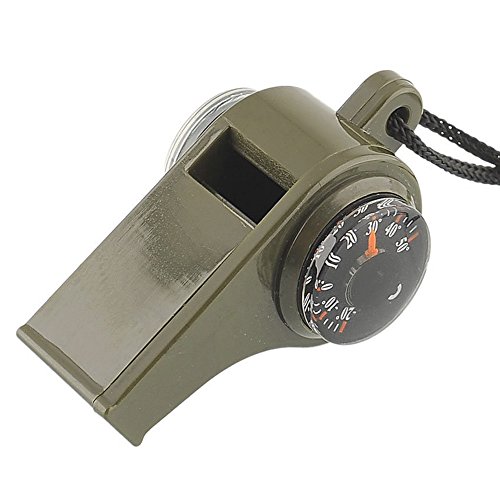You'll want five essential pieces of gear for safe hiking adventures in 2025. Start with a lightweight 3-in-1 emergency whistle that includes a compass and thermometer for navigation and weather monitoring. Pack compact Mylar thermal blankets that reflect 90% of body heat and serve multiple survival purposes. Don't forget an 85-piece first aid kit in a water-resistant case for medical emergencies. Add a 20-in-1 survival paracord bracelet with LED light and basic tools. Finally, bring portable LED tent lights that provide 150 lumens of brightness in three modes. Let's explore how to choose and use this gear effectively.
Key Takeaways
- A comprehensive first aid kit in a water-resistant case with customizable compartments ensures safety during unexpected emergencies or injuries.
- Mylar thermal blankets provide essential protection against hypothermia while serving multiple purposes as shelter and signaling devices.
- Multi-functional survival tools like the paracord bracelet combine navigation, light, and emergency response capabilities in one wearable device.
- Reliable lighting solutions with water-resistant features and multiple brightness modes ensure visibility during nighttime or low-light conditions.
- Emergency whistles with built-in navigation tools offer crucial safety features for alerting rescuers and maintaining directional awareness.
Emergency Whistle with Compass & Thermometer for Outdoor Survival
- 3 function: whistle, Waterproof thermometer, Waterproof compass
- Temperature range: -20~50 degrees Celsius, Size:6*3*3cm (2.4*1.2*1.2 inch)
- Green Body; Comes with Lanyard. On one side there is a compass, and the other is Celsius...
Whether you're a seasoned hiker or a weekend adventurer, a reliable emergency whistle can make the difference between a close call and a crisis. The TTSAM Emergency Whistle offers more than just a powerful sound – it's a compact 3-in-1 survival tool that'll keep you oriented and informed in the wilderness. You'll appreciate its built-in waterproof compass for navigation and temperature gauge that reads from -20 to 50 degrees Celsius, all packaged in a durable army green housing that weighs just 9 grams.
Don't let its small size fool you – this 2.4-inch powerhouse clips easily to your backpack with its 42.5 cm lanyard and has earned solid 4.4-star ratings from outdoor enthusiasts. While some users note the whistle could be louder, you'll find it's more than adequate for most emergency situations, and its waterproof features mean you can rely on it even in challenging weather conditions.
Best For: Outdoor enthusiasts, hikers, and campers seeking a lightweight, multi-functional survival tool that combines essential navigation and emergency signaling capabilities.
Pros:
- 3-in-1 functionality combining whistle, compass, and thermometer in a compact design
- Extremely lightweight at 9.07g and waterproof construction
- Durable plastic construction with included lanyard for easy carrying
Cons:
- Whistle volume could be stronger for emergency situations
- Limited temperature range (-20 to 50°C)
- Some users report concerns about lanyard quality
Emergency Mylar Thermal Blankets (4-Pack) for Survival & Outdoors
- Emergency Protection: Highly reflective Mylar fabric traps heat and provides warmth in cold or...
- Space-Saving Design: Compact and lightweight, perfect for packing in backpacks, bug-out bags,...
- Durable & Versatile: Made of heavyweight Polyester, suitable for camping, hiking, fishing, and...
Serious hikers and outdoor enthusiasts trust Emergency Mylar Thermal Blankets as an essential safety component in their gear. You'll find these lightweight, compact blankets invaluable when facing unexpected weather changes or emergency situations on the trail, as they reflect up to 90% of your body heat back to you, preventing hypothermia and shock.
These versatile lifesavers aren't just for warmth – you'll discover they're incredibly adaptable for various outdoor needs. Whether you're using them as an emergency shelter, ground cover, rain poncho, or even a signal for rescue with their bright orange side, they're remarkably practical. Each blanket in the 4-pack measures 84 by 55 inches, and while they might make a bit of rustling noise, their ability to withstand extreme temperatures and protect you from the elements makes them worth their weight in gold in your hiking pack.
Best For: Hikers, campers, and outdoor enthusiasts who need lightweight, compact emergency protection against cold and harsh weather conditions.
Pros:
- Excellent heat retention, reflecting up to 90% of body heat
- Extremely versatile with multiple uses (shelter, ground cover, rain protection, signaling)
- Lightweight and compact design makes them easy to carry in any emergency kit
Cons:
- Noisy material can be disruptive when in use
- Difficult to repack once opened from original packaging
- Not environmentally friendly due to non-biodegradable Mylar material
I GO 85 Pieces Compact First Aid & Emergency Survival Kit
- 【Essential Preparedness Kit】: Contains 85 essential first aid supplies for treating common...
- 【Safety Medical Kit】: Safety approved, 85 pieces of comprehensive first aid treatment...
- 【Organization Survival Pouch】: Clear mesh lining and two-way full open zippers in...
Every hiker's safety arsenal should include the I GO 85 Pieces Compact First Aid & Emergency Survival Kit, a lightweight yet thorough medical companion that won't weigh down your pack. At just over half a pound and sporting a water-resistant EVA case with clear mesh compartments, you'll find everything organized and easily accessible when you need it most.
You'll appreciate the kit's clamshell-style opening and included carabiner, making it simple to attach to your daypack or hang from a tent loop during camping trips. While the basic 85-piece supply set covers common injuries and emergencies, you'll want to customize it by swapping out the basic scissors and tweezers for higher-quality alternatives. Don't forget to add your preferred medications and some anti-itch cream to make this compact kit truly your own perfect trail companion.
Best For: Hikers, campers, and outdoor enthusiasts seeking a lightweight, basic first aid kit that can be easily customized for their specific needs.
Pros:
- Extremely compact and lightweight design with convenient clamshell opening
- Water-resistant EVA case with clear mesh compartments for easy organization
- Includes carabiner for easy attachment to backpacks or hanging in tents
Cons:
- Basic scissors and tweezers need upgrading for better quality
- Missing essential medications and anti-itch treatments
- Medical cross on case could be more visible for emergency situations
20 in 1 Survival Paracord Bracelet Adjustable Gear Kit
- 【20 in 1 Survival Bracelet】: it includes more survival tools: Upgrade compass, SOS led...
- 【SOS LED Light】: It is a key to seek or implement rescue. The LED light has three modes:...
- 【Upgrade Compass & Rescue Whistle】: Updated compass has a diameter of 0.79” dial bigger...
Modern hikers seeking compact emergency gear will appreciate the 20-in-1 Survival Paracord Bracelet. This wearable survival kit packs an impressive array of tools, including an SOS LED light with three modes that's visible up to 32 feet away, a high-decibel whistle for emergencies, and a built-in thermometer for monitoring weather conditions.
You'll find the bracelet's 10-foot paracord particularly versatile, as it can support up to 550 pounds – perfect for emergency shelter building or creating makeshift repairs on the trail. While the 0.79-inch compass isn't going to replace your primary navigation tools, it's a reliable backup that could prove invaluable if you lose your bearings. The bracelet's 4.2-star rating from over 2,000 users suggests it's a worthwhile addition to your hiking arsenal, though you'll want to test the LED and compass functions before heading out.
Best For: Outdoor enthusiasts and hikers who want a lightweight, wearable emergency kit that combines essential survival tools in a compact form factor.
Pros:
- Versatile 10-foot paracord rated for 550 pounds provides multiple emergency uses
- Multiple built-in tools including LED light, whistle, and thermometer in a wearable format
- Strong customer rating (4.2/5) from over 2,000 users suggests reliable performance
Cons:
- LED light functionality reported to be unreliable by some users
- Compass size (0.79") may be too small for precise navigation
- Thermometer readings can be difficult to read and interpret accurately
FLY2SKY Portable LED Tent Lights (4 Pack)
- Compact, Long Lighting: Palm sized(5.7 X 2.1 inch) portable led tent light, takes up very...
- Brightness 150 Lumens: Each battery operated camping lights built in 3 LED tent lamps beads,...
- 3 Light Modes Support Multi Application: The LED tent light bulbs comes with 3 light modes:...
Smart campers looking for reliable illumination will appreciate the FLY2SKY Portable LED Tent Lights' versatility and convenience. These lightweight powerhouses pack 150 lumens of brightness into a compact 5.7-inch frame, making them perfect for your outdoor adventures. You'll get four lights in the set, each featuring three modes – high, low, and strobe – to adapt to any situation you encounter.
What you'll love most is how these lights can transform your camping experience. They're IPX8 water-resistant, so you won't need to worry about rain or splashes, and the sturdy carabiner hook lets you hang them anywhere. Whether you're reading in your tent, creating ambiance for a campsite gathering, or dealing with an unexpected power outage at home, these portable LEDs have got you covered. Just remember to pack extra AAA batteries, as they're not included in the package.
Best For: Outdoor enthusiasts and campers seeking reliable, versatile lighting solutions that can serve multiple purposes from campsite illumination to emergency backup lighting.
Pros:
- Versatile 3-mode lighting system with impressive 150-lumen output
- Durable IPX8 water-resistant construction with convenient carabiner attachment
- Comes in a value pack of 4 lights with multi-color options for easy identification
Cons:
- Batteries not included and requires 3 AAA batteries per light
- Limited battery life of 10-15 hours on high mode
- Relatively basic design without advanced features like USB charging or dimming capabilities
Factors to Consider When Choosing Essential Gear for Hiking and Outdoor Adventures
When you're planning your next hiking adventure, you'll need to weigh several vital factors that'll shape your gear choices, from the weather forecast to how long you'll be out on the trail. Your safety should be the top priority, which means carefully selecting equipment that can handle emergency situations and protect you from the elements you're likely to encounter. Whether you're heading out for a day hike or a week-long trek, you'll want to strike the perfect balance between durability and weight, ensuring your pack contains high-quality gear that won't weigh you down or let you down when you need it most.
Weather and Season Impact
Three critical weather factors shape the gear choices for any hiking adventure: temperature, precipitation, and seasonal variation. You'll need to carefully consider how these elements interact before selecting your equipment, as the wrong choices could leave you uncomfortable or even at risk.
When you're planning your hike, remember that mountain weather can change in minutes, not hours. You'll want gear that's versatile enough to handle these rapid shifts, especially in areas where afternoon storms are common. During summer months, you're looking at lightweight, breathable materials that'll keep you cool while protecting you from harmful UV rays – think moisture-wicking shirts and wide-brimmed hats. In contrast, winter hiking demands insulated layers that trap body heat and prevent hypothermia.
Don't forget about those tricky shoulder seasons – spring and fall can throw multiple weather patterns at you in a single day. You'll need waterproof gear that's also breathable, plus emergency items like compact thermal blankets. The key is building a gear system that's adaptable enough to handle whatever Mother Nature decides to throw your way.
Safety and Emergency Preparedness
Preparing for outdoor emergencies requires a strategic approach to safety gear selection. You'll want to start with a multi-functional emergency whistle that's not just any ordinary noisemaker – it's your lifeline in tough situations, complete with built-in compass and thermometer features that'll keep you oriented and aware of environmental conditions.
Don't underestimate the importance of an Emergency Mylar blanket in your pack, as it's a lightweight superhero that retains 90% of your body heat when you need it most. You'll also want to personalize a compact first aid kit to match your specific needs, ensuring you're ready for whatever scrapes and bumps the trail throws your way. Consider wearing a paracord bracelet that doubles as a survival tool kit – it's like having a mini emergency response team right on your wrist. For nighttime safety, pack a reliable LED tent light that won't leave you in the dark when you need visibility most. Remember, these aren't just accessories; they're your insurance policy against the unexpected turns that make outdoor adventures both exciting and challenging.
Durability and Material Quality
Before hitting the trails, you'll need to evaluate gear materials with the same precision as planning your route. When you're miles from civilization, the durability of your equipment isn't just about comfort – it's about survival. Your gear's material quality can make the difference between an epic adventure and a miserable experience.
Start by focusing on pieces made from robust nylon and high-performance plastics, which won't let you down when the going gets tough. You'll want waterproof and windproof materials for your shelter and blankets, ensuring you'll stay warm and dry even when Mother Nature throws her worst at you. While durability is vital, don't forget about weight – modern materials can offer both strength and lightness, so you won't feel like you're hauling rocks up the mountain.
Pay close attention to user reviews that highlight real-world performance, as they'll give you insights that manufacturer specs can't capture. For electronic gear like headlamps and GPS devices, you'll need water-resistant construction that can handle unexpected downpours. Remember, investing in quality materials now means fewer replacements and more reliable performance when you need it most.
Trip Duration Planning
Smart adventurers know that trip duration shapes every aspect of gear selection for the trail. You'll need to carefully match your equipment choices to the length of your journey, ensuring you're neither overloaded with unnecessary items nor caught short without essentials. When you're planning a day hike, you might get by with lightweight basics, but multi-day adventures demand more substantial gear and backup options.
Your physical condition plays an essential role in determining what you can comfortably carry and how far you'll travel each day. If you're new to hiking, you'll want to start with shorter trips and lighter loads while building up your endurance. Weather considerations will also impact your gear choices – you'll need to pack extra layers and emergency supplies if you're heading into areas known for unpredictable conditions. Don't forget to factor in adequate water planning, especially for longer treks where reliable sources might be scarce. Most importantly, build rest periods into your schedule; even the most robust gear won't compensate for an exhausted hiker who's pushed too hard without proper breaks.
Pack Weight Limits
Throughout your hiking journey, maintaining appropriate pack weight stands as a critical factor between an enjoyable adventure and a grueling ordeal. You'll want to keep your total pack weight between 20-25% of your body weight, ensuring you're not overburdening yourself on the trail. For those multi-day adventures you're planning, aim to keep your complete setup under 30 pounds, including those essential snacks and water supplies.
Here's a pro tip you'll thank yourself for later: start with a base weight of 10-15 pounds for your three-season gear, then strategically add other necessities. Every pound counts, and you'd be amazed at how dropping just 5 pounds from your pack can boost your endurance and keep those aches and pains at bay. When you're loading up your backpack, think like a physics expert – place heavier items close to your back and centered near your natural balance point. This simple adjustment will make your pack feel considerably lighter, even if you're carrying the same weight. Remember, it's not just about what you pack, but how you pack it.
Frequently Asked Questions
How Long Should I Break in New Hiking Boots Before a Major Trek?
You'll want to break in your new hiking boots for at least 2-3 weeks, wearing them on short walks, around the house, and during several shorter hikes before attempting a major trek.
What's the Recommended Hiking Group Size for Beginners on Mountain Trails?
Ready to hit the trails? You'll want to hike with 4-6 people when you're starting out. It's safer than going solo, allows for buddy support, and isn't too large to manage effectively.
How Much Water Should I Carry per Hour of Hiking?
You'll need about 1/2 to 1 liter of water per hour of hiking, depending on weather conditions, trail difficulty, and your exertion level. Don't forget to pre-hydrate before starting.
Are Trekking Poles Necessary for Day Hikes Under Five Miles?
Light as a feather, you don't need trekking poles for short day hikes under five miles. They're helpful for stability on rough terrain but aren't essential unless you've got knee issues.
What's the Best Time of Day to Start a Challenging Hiking Trail?
You'll want to start challenging hikes early in the morning, ideally before sunrise. It's cooler, less crowded, and gives you plenty of daylight to complete your trek safely.
Conclusion
When you're hitting the trails, you'll want these five essential pieces of gear that'll serve as your lifeline in the wilderness. Like a well-orchestrated symphony, each item plays its vital role in keeping you safe and comfortable. From the humble whistle that could echo through valleys to the high-tech LED lights illuminating your evenings, you're now equipped to tackle any outdoor adventure with confidence and preparedness.
Last update on 2025-07-12 / Affiliate links / Images from Amazon Product Advertising API








